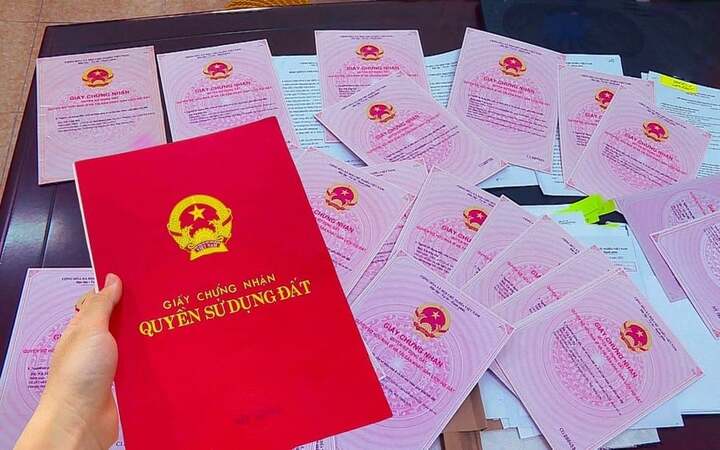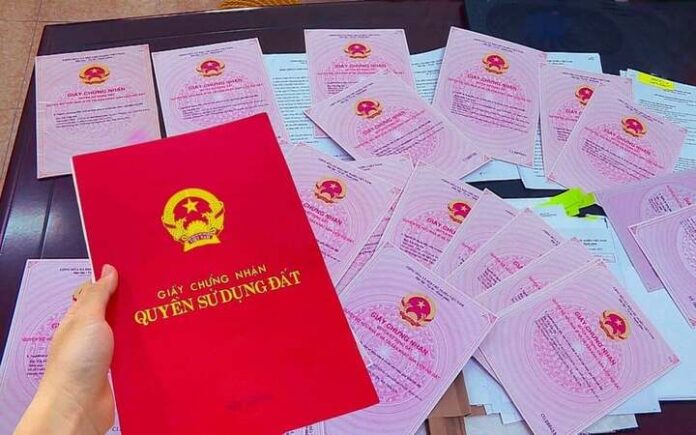In response to this query, the Ministry of Agriculture and Environment clarified that in cases of land registration, transfer, and alteration of land parcel addresses, if the applicant wishes to undertake multiple procedures simultaneously, the responsible authorities are obliged to liaise with relevant competent authorities to facilitate these procedures without mandating sequential processing.
Specifically, in a recent communiqué to the People’s Committees of provinces and cities, the Ministry emphasized that the rectification of land records, including cadastral maps, land registers, land books, and land-use right certificates, must occur concurrently with the update and rectification of local land databases.

Will residents need to re-apply for land use rights certificates after provincial mergers?
Existing land records and databases that are being managed, archived, and operational will continue to be utilized to provide services to citizens and businesses.
The rectification of land records and databases due to administrative rearrangement must occur simultaneously with the resolution of administrative procedures related to land and attached assets. This ensures a seamless and unhindered process for citizens and enterprises.
Notably, the communiqué stated that after administrative rearrangement, there is no mandatory requirement to simultaneously rectify previously issued certificates, unless there is a demand from land users or owners of assets attached to land, or if it coincides with administrative procedures related to land.
The alteration of land parcel information (sheet number, parcel number, and address) on previously issued certificates shall adhere to the provisions outlined in Clause 5, Article 41 of Circular 10/2024.
Specifically, Clause 5 stipulates that the address of assets attached to land shall be presented as follows: the name of the work or building (if any); house number, apartment number, alley, branch, street name (if any), settlement name, and administrative unit names at the commune, district, and provincial levels.
The communiqué clarified that in cases where there are no blank lines left on the issued certificates for alterations, new certificates shall be issued to reflect the land parcel information as per the provisions of Clause 6, Article 23 of Decree 101/2024.
Clause 6 stipulates the circumstances for registering changes in land-use rights and ownership of assets attached to land when there are no blank lines left on the issued certificates for alterations, or when land users or owners of assets attached to land express their desire for new certificates.
The text also emphasized that the land-use right certificate issuance records established by the district-level land management function must be handed over to the branch of the Land Registration Office immediately after administrative rearrangement for archiving purposes.
As for electronic land records that are archived and operational within the land database, agencies shall continue to exploit and manage them, providing services to citizens and businesses in accordance with current regulations.
The New Red Book Rules: 4 Key Changes Effective July 1st That Every Homeowner Needs to Know
“Simplifying the Red Book Process: Unraveling the Four New Regulations Effective from July 1st.
As we approach the implementation date of new land regulations, it is crucial for citizens to understand the changes. These regulations, effective from July 1st, streamline the process of obtaining a Red Book, especially with the elimination of the district-level approval. Get informed and stay ahead to ensure a smooth and legal journey in the realm of land ownership.”
“Unmarked Land, Don’t Rush to Build: A Word of Caution for Eager Homeowners.”
Under the Land Law of 2024, land users are obligated to utilize their land within the defined boundaries and parcel landmarks.
“The Ultimate Land Auction: Bidding Wars Reach Sky-High Prices in Hanoi’s Suburban Districts”
The 76 land lots in Phu Xuyen District, Hanoi, were successfully auctioned, with the highest bid reaching an impressive 62 million VND per square meter. This prime real estate is strategically located near major transportation routes and boasts a well-developed technical infrastructure. Its proximity to the southern development axis of Hanoi promises great potential for future growth and development.





















